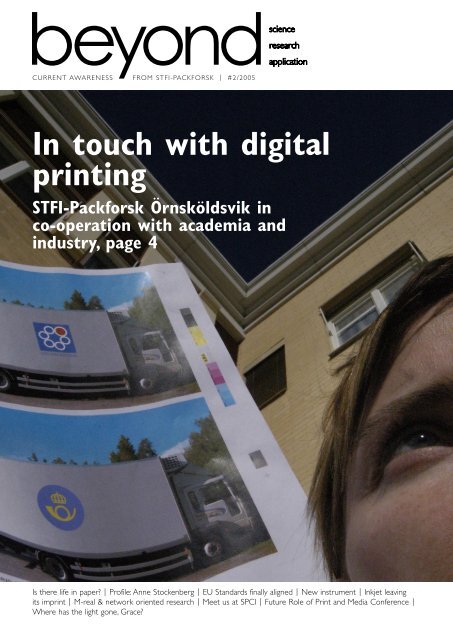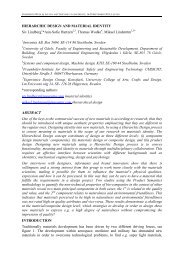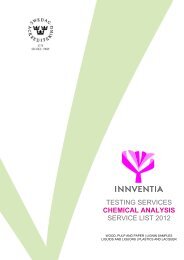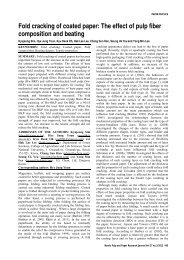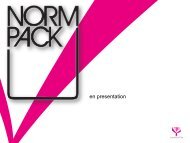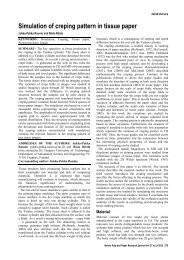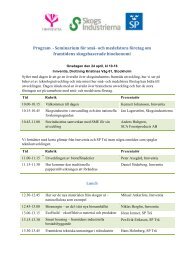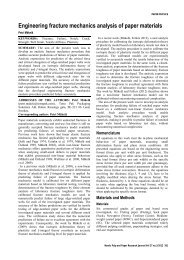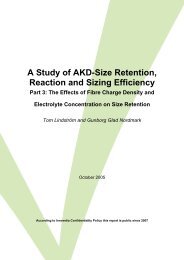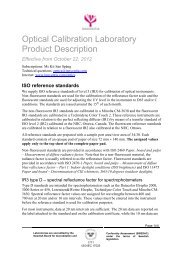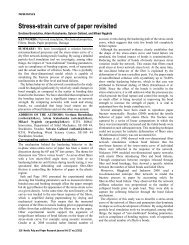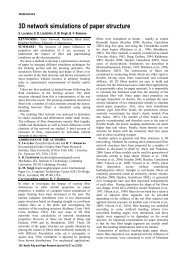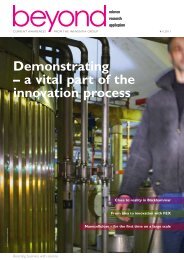Beyond 2, 2005 - Innventia.com
Beyond 2, 2005 - Innventia.com
Beyond 2, 2005 - Innventia.com
- No tags were found...
Create successful ePaper yourself
Turn your PDF publications into a flip-book with our unique Google optimized e-Paper software.
CURRENT AWARENESS FROM STFI-PACKFORSK | #2/<strong>2005</strong>In touch with digitalprintingSTFI-Packforsk Örnsköldsvik inco-operation with academia andindustry, page 4Is there life in paper? | Profile: Anne Stockenberg | EU Standards finally aligned | New instrument | Inkjet leavingits imprint | M-real & network oriented research | Meet us at SPCI | Future Role of Print and Media Conference |Where has the light gone, Grace?
Ewa Lie and Anne Stockenberg are two of the researchers at theSTFI-Packforsk microbiology laboratory. According to them, thelaboratory is expertly equipped to carry out all kinds of microbiologicalanalyses.Is there lifein paper?Is there life in paper after a papermachine? This question may beanswered in various ways, e.g. apaper’s manner of expressing itselfor its tendency to change.The expert microbiologists at the STFI-Packforsk microbiology laboratory studythe life that, of itself, exists in paper;micro-organisms that can not only beinjurious to health when <strong>com</strong>ing in contactwith food products but that maycause costly interruptions to productionin the manufacturing processes. Thereare certain organisms that can evenform resistant spores. These are calledendospores and may remain even afterthe drying section of a paper machine.“One sign of the survival capabilityof an endospore is that they are whatresearchers are in quest of, when lookingfor life on Mars,” says Ewa Lie who isresponsible for work in the microbiologylaboratory. “Micro-organisms can be thecause of slime being formed which, inturn, can give rise to spots or holes in apaper and, in the worst instance, cause aweb break. They can also cause corrosiondamage to process equipment.”According to Ewa Lie, it is quite <strong>com</strong>monfor a mill to try to elude a problemby adding more chemicalsto stop the work of theorganisms. This, however, ismerely a way of treating thesymptom rather then curingthe cause of the disease.If there are problemswith processes or production,it can be beneficial tocarry out a system analysisto find potential problemorganisms.“In principal, this meanslooking at the process equipmentwith microbiologicaleyes,” adds Ewa.Since micro-organismsare living matter that performdifferently, dependingon their environment, therecannot be a <strong>com</strong>mon solutionto every problem. Byusing tailor-made methodsadapted to the environmentof a particular mill, there is abetter chance of finding thesource of a problem in themicrobiology laboratory.One of the latest methodsis to look at non-cultivablebacteria with the assistance of molecularmethods.Customer demands on foodstuff packaging,without the presence of substanceshazardous to health, has put focus onproduction processes but from a microbiologicalperspective.Ewa concludes, “At STFI-Packforsk,we are more than prepared to meet newdemands from the industry for excellentand reliable testing methods based on ourfrontline research.”•CONTACT: ewa.lie@stfi.seDet mikrobiologiska laboratorietvid STFI-Packforsk studerar de levandemikroorganismer som finns i papperet ochsom inte bara kan vara hälsovådliga i kontaktmed livsmedel utan också kan orsakakostsamma produktionsstörningar i tillverkningsprocessensom t ex slembildningoch korrosionsskador. En vanlig åtgärd äratt tillsätta kemikalier för att stoppa organismerna,säger Ewa Lie som leder arbetetinom laboratoriet, men enligt henne botarman då endast symptomen. Ett bättre sättär att göra en systemanalys för att hittaeventuella problemorganismer.Eftersom mikroorganismer är levandemateria som uppträder olika beroende påomgivningen, kan man inte ha en generelllösning för varje problem. Genom skräddarsyddametoder som är anpassade fördet enskilda brukets miljö, har man påmikrobiologilaboratoriet bättre möjligheteratt hitta källan till problemen.ProfileAnneStockenbergAnne Stockenberg is a Major ProjectManager and one of the experts at STFI-Packforsk in the field of microbiology.Working with the forest industry wassomething quite new to her when shetook up her appointment in the Companythree years ago. During her time at theMicrobiology Department at StockholmUniversity, it was the sea rather than theforest that was her focus when she studiedhow microbial processes in the sedimentaffect eutrophication in the BalticSea, among other things.When asked why it is interesting towork with micro-organisms, she repliesthat they are fascinating.“It is an invisible world that influencesan incredible number of things.” she says.She describes an old branch of learningwith classical methods that have undergonedevelopments in the last thirty yearsthrough the influence of molecular biology.It has provided us with new tools forstudying micro-organisms. As a result, it ispossible to see that the microbial world ismore sophisticated and diverse than waspreviously believed.“New species and types have been discovered,which has meant, among otherthings, that the evolutionary developmenttree has had to be redrawn,” she says.Anne began her studies in humanities,with a deep interest in languages. Afterthis, she spent many years abroad, inChile, Algeria and Cuba. However, whenshe changed her profession to science in1987, it was as if an entirely new worldhad opened up to her. Nevertheless, sheviews her humanities background as a<strong>com</strong>plete asset. It makes it possible forme to have a broader perspective, to seeproblems from different aspects.”Her interest in biology is given furtherexpression when, in her leisure time, shelikes to potter in her own garden at hercountry place in Västmanland.•CONTACT: anne.stockenberg@stfi.se2 | <strong>Beyond</strong> #2/<strong>2005</strong> Current awareness from STFI-Packforsk
EU Standardsfinally alignedAfter many years, the six standards that theEuropean Standardisation Organisationhad set up as methods for <strong>com</strong>panies todemonstrate that they conform to the EUPackaging Directive, have been broughtinto line by the EU Commission. Thismeans that there is now an authoritativelyapproved method to show that a packageaccords with the so called EssentialRequirements of the EU Directive. Thisalso indicates that every European countryhas to establish a course of action inaccordance with the standards.Due very much to the involvement ofSTFI-Packforsk, Sweden is one of the leadingcountries to be actively involved inthe ground work with these Standards.“Our starting point was to create practicalstandards instead of general guidelines,”says Ann Lorentzon who, togetherwith Anders Sörås, has worked on therequirements of the Standards. “Thisinvolves a constant questioning of packagingwhile, at the same time, it opens upthe possibility of future solutions involvingnew materials or functions.”This involvement has resulted inthe creation of the Trade and IndustryMiljöpack Group that supports <strong>com</strong>paniesin their work to adapt their Q.A.systems to conform to the Standards.•CONTACT: ann.lorentzon@stfi.seNew instrumentSTFI-Packforsk has recently invested in a new surface profilometer, called FRT afterFries Research & Technologies, a German manufacturing <strong>com</strong>pany. The instrumentworks on the chromatic aberration principle. This is an optical non-contact methodwhere the colour <strong>com</strong>position of the reflected light is analysed and translated into aheight position, similar to confocal microscopy.The instrument is equipped with a topography sensor and a CCD camera, which isused to define start and end positions for a measurement, by locating marks or printedareas on the surface, for example.The data is evaluated in separate software, where <strong>com</strong>mon surface parameters,height maps, profiles and pictures are generated. Raw data can be exported for customdata evaluation in Matlab, for instance.Up to now, FRT has been tested on uncoated and coated papers, metal, PE coatedboard and marble.•CONTACT: michael.karathanasis@stfi.seInkjet leaving itsimprintThe STFI-Packforsk regional establishmentin Örnsköldsvik is working withseveral interesting projects. MarianneKlaman, a Major Project Manager inStockholm, is responsible for the researchprogramme in Örnsköldsvik. She emphasisesthree current projects that are in linewith STFI-Packforsk operations and thatfortify the Company’s expertise.High quality printing with inkjetWith inkjet technology, it is possible toprint out colour pictures with the bestquality, even at home. Researchers havehad photos developed from a digitalsource at a conventional photo lab and<strong>com</strong>pared them with the same photosthat have been printed out on three differentinkjet printers.Inkjet printouts have a very wide col-our range as well as a good colour reproduction,in most cases, with as good asor better quality as the conventionallydeveloped photos. Uniformity and thereclamation of detail have been goodtoo.For a printout, the software in a printeris used and the programmes from the differentsuppliers can differ slightly. Thereis always a continual upgrading and thedevelopments go swiftly. Achieving thebest quality requires an increasing levelof know-how by the user. The technologyis relatively expensive. Anyone whochanges an ink cartridge in their printer athome is only too well aware of this fact.The project was launched with abroader pre-study and has consequentlybeen run in collaboration with M-realwhich has digital printing as one of Current awareness from STFI-Packforsk <strong>Beyond</strong> #2/<strong>2005</strong> | 3
its interests. A report will be producedbefore June. It is awaited with anticipationby the paper industry, photo labs and<strong>com</strong>panies that have a niche in the fieldof photo printouts.Hybrid printingAnother project concerns the <strong>com</strong>binationof conventional flexography withinkjet. There is an increase in flexibilityand the opportunities of tailor-makingthe product to the needs of the customerwhen utilising fill-in printing with inkjetat the end of the production line.Marianne Klaman means that STFI-Packforsk is in a good position these dayswith this project and that there is a lot tobring to this area. The big developers areworking with this and, so far, it is a smallbut significant niche, especially of interestwhen it <strong>com</strong>es to the field of packaging.Packaging material is often adaptedfor a certain printing technique, giving<strong>com</strong>pletely different results with anothertechnique. There is still a great deal ofdelicate problems to find solutions to.Xerography on PE coated surfacesIn the third example, some research hasbeen carried out on ream wrapping (thesomewhat stiffer paper around a sheaf ofcopying paper) with xerography, whichleads to the possibility of personalisedprinting.Marianne Klaman certainly wants totake things further in this area. Theinteresting thing about this is <strong>com</strong>biningtechnology with materials. This will probablyinterest the packaging market whenit <strong>com</strong>es to PE coated board and other PEcoated materials.•CONTACT: marianne.klaman@stfi.seSTFI-Packforsks forskningsetableringi Örnsköldsvik omfattar fleraintressanta projekt, exempelvis High qualityPrinting med inkjet, hybridtryck samtxerografi på polyetenbelagda ytor. Medinkjet teknik är det möjligt att printa utfärgbilder med den bästa kvalitet på vanligabläckstråleskrivare. Utskrifterna i projektetsom har drivits i samarbete med M-real,har haft ett mycket stort färgomfång, ävenfärgåtergivning i de flesta fall, och minstlika bra kvalitet eller till och med bättreän konventionellt framkallade foton. Attkombinera konventionell flexografi medinkjet är en smal men mycket betydandenisch som är intressant framför allt förförpackningsområdet. Med tilltryck i inkjetsent i fyllningslinjen ökar flexibiliteten ochmöjligheten att kundanpassa produkten.I det tredje exemplet, xerografi på polyetenbelagdaytor, har viss forskning gjorts pårisomslag, vilket ger möjlighet till personifieradetryck. Det intressanta är att kombinerateknik och material.In touch withdigital printingDigital printing technology is one recent contribution to theSTFI-Packforsk business. It is a technology that is gaining strongground offering a lot of advantages and new businessopportunities.“One way for paper mills and the packagingindustry to discover new businessopportunities is to develop products suitablefor digital printing. This naturallyrequires knowledge about this printingtechnique,” says Malin Wedin who is theregional contact person in Örnsköldsvik.Some years ago, a regional CompetenceCentre for digital printing technology,DPCOM, was founded. It <strong>com</strong>prisesthe Digital Printing Center (DPC), theMid Sweden University in Sundsvall andSTFI-Packforsk. M-real, SCA and theprinting industry in the region, amongothers, are behind the investment. Its aimis to strengthen the <strong>com</strong>petitiveness ofthe industry through research and developmentand by making evaluations of thetechnology and the market.“This is a good example of how academies,institutes and <strong>com</strong>panies fromvarious fields can work together to attainfurther heights,” says Clas Engström,Operations Manager at DPC.When DPCOM was founded, themotto was, “We will not be in <strong>com</strong>petitionbut invest in a joint CompetenceCentre instead.” A new printing laboratoryhas been built, with climate controlequipment that makes it possible to regulatethe temperature and relative humiditywhen printing is in progress. For paper,environment is very significant since thequality and condition of a paper has aneffect on the printing.“STFI-Packforsk now finds itself in astrong position, with paper, packagingand printing on its programme,” addsMalin Wedin.In its simplest form, digital printinghas been around since the 1980s. Manypeople must surely remember receivingthose initial direct-addressed letterscontaining advertising matter. The technologyof today is developinga great deal and it will provideenormous opportunities forhigh qualitative colour printingwith static or variable texts andpictures.This technology means thateach printing can be varied,since it goes directly from a<strong>com</strong>puter to the printing press.With conventional printingmethods, there is a middle stepusing printing plates, and so larger editionsare needed for the printing to beprofitable.New opportunitiesRapid developments are taking place anda lot is happening in the fields of printingand packaging. The motive forces aremany, e.g. the increased speed of information,smaller editions, more specificinformation, diversified editions and lesstied-up capital as a result of a reductionin stock. For <strong>com</strong>panies, this meansthat they can offer business models andservices that are impossible with conventionalprinting.This, however, places demands on thepapers, the inks, the processing and otherthings. The STFI-Packforsk Örnsköldsvikstaff, consisting of four doctoral candidates,one postdoc and Malin Wedin,work closely with the <strong>com</strong>panies standingbehind the Competence Centre. Withtheir colleagues in Stockholm, a greatdeal of know-how and knowledge aboutproperties, qualities and the evaluationof printing, papers and packages is beingdeveloped.Hybrid printing“Customer adapted information on packages”is the title of a project that recently4 | <strong>Beyond</strong> #2/<strong>2005</strong> Current awareness from STFI-Packforsk
Thomas Mejtoft, Åsa Gidlund, Magnus Viström and Jakob Norstedt-Moberg are doctoral candidates atSTFI-Packforsk in Örnsköldsvik.resulted in a licentiate’s dissertation.Doctoral candidate Magnus Viströmsays, “The prospect of applying digitalprinting technology to packages is beingstudied in this project.”“By way of introduction, we identifiedthe motive forces and limitations byusing customer adapted information onpackages. Then our focus was on lookingat where, in a value chain, a digital fill-inprinting can be done and what logicalconsequences this results in. We have alsoidentified the important critical factors tobe aware of when a digital fill-in printingunit is being integrated into a packagingline.”The results show that customer adaptedinformation on packages is of interestin order to <strong>com</strong>ply with the altogetherhigher market demands on flexibility andshort production series and to create customerbenefits as well. Magnus Viströmsuggests that it is feasible to make logisticalimprovements and to raise the level ofdelivery services by integrating a digitalprinting unit inline on a packaging line.“However, it is vital to keep in mindthat a digital printing unit, integratedinline, carries certain risks with it.”Web-to-printThe internet has provided a new potentialfor ordering printed matter using websolutions. This is called ‘web-to-print’. Allthe programmes and templates are at theprinter’s and customers are able to fill ina document with their own information.Malin Wedin mentions the production ofbusiness cards as an example.“The printer has a layout template,especially created with the <strong>com</strong>pany logoand other static information. Using theinternet on their own <strong>com</strong>puters, staffmembers are able to fill in personaldetails on the template. When an orderhas been authorised by someone qualified,printing of the desired number ofitems takes place.”“This is fast. There is no need forexpensive software or a high level ofknow-how on the part of the customer.It’s such a simple business.”Digital technology seems to presentunlimited possibilities. Need and technologygo hand in hand and any problemsare solved along the way.•CONTACT: malin.wedin@stfi.seDigital tryckteknik är ett avde viktiga tillskott till agendan som STFI-Packforsk har fått som storinstitut. Teknikeninnebär att varje tryck kan varieras eftersomdet går direkt från en dator till tryckpressen.För några år sedan etablerades ett regionaltkompetenscentrum för digital trycktekniki Örnsköldsvik, som består av DigitalPrinting Center (DPC), Mittuniversitetetoch STFI-Packforsk. Avsikten är att stärkaindustrins konkurrenskraft genom forskning,utveckling och utvärdering av marknadoch teknologi.– Det här är ett bra exempel på hurakademi, institut och företag från olikaverksamheter arbetar tillsammans för attnå längre, säger Clas Engström verksamhetschefvid DPC.Drivkrafterna inom trycksaks- och förpackningsområdetär många; ökad informationshastighet,mindre upplagor, mer riktadinformation, varierade utgåvor och minskadkapitalbindning. För företagen innebärdigitaltryck att kunna erbjuda affärsmodelleroch tjänster som inte är möjliga medkonventionellt tryck.Current awareness from STFI-Packforsk <strong>Beyond</strong> #2/<strong>2005</strong> | 5
Participation in the various Research Programmes that have gone from national-based research projectsto research on the European market signifies increased opportunities for making contacts with newparties. Aerial view of the M-real Husum Mill.M-real & network orientedresearch“With R & D, our general philosophyand vision is network oriented,” saysSune Wännström, Assistant VicePresident of M-real CorporationCentre in Örnsköldsvik. “The institute,the university and the Companyare important parties in our researchnetwork when it <strong>com</strong>es to customersand suppliers.”PHOTO: M-REALSune Wännström, Assistant Vice President ofM-real Corporation Centre in Örnsköldsvik hashad valuable experience as a Partner Customer atSTFI-Packforsk. He regards contract research as anexcellent <strong>com</strong>plement for meeting the needs ofthe different units in the <strong>com</strong>pany.M-real has been a Partner Customer ofSTFI-Packforsk for many years and, inthe latest research programme, it hasbeen an active participant in many of theclusters.“In principal, it’s only the NewsprintCluster that we don’t take part in,” saysSune Wännström. “And the reason forthat is simply because we don’t producethat kind of paper.”Valuable experiencesAt M-real, they actively participate in thedevelopment of the forth<strong>com</strong>ing threeyear STFI-Packforsk Research Programme,offering opinions, from the point of viewof the Company, on important issues concerningresearch.“In addition to participating in the variousResearch Clusters, our experiencesfrom contract research have been valuable,which has been a good <strong>com</strong>plement,”says Sune Wännström. “Putting aside aportion of our annual financing towardsthis has worked out extremely well for us.This might include anything from trialson EuroFEX, the STFI-Packforsk papermachine, to visual evaluation with the aidof perception studies.”More interfaceHe emphasises the function of theResearch Programme concerning the significanceof meeting other <strong>com</strong>paniesfrom different parts in the value chain.This provides more opportunities forinterface, which in turn can generate jointdevelopment projects.“Earlier on, there were fewer playerson the market and research made a muchgreater impression nationally. These daysall our research investments take placeon a European playing board as well asamong an increasing level of <strong>com</strong>petition,”adds Sune Wännström.•CONTACT: malin.wedin@stfi.se– Vår generella filosofi och synpå FOU är nätverksorienterad, säger SuneWännström, Assistent Vice President vidM-real Corporation Technology center iÖrnsköldsvik. Institut, universitet samt företagpå både kund- och leverantörssidan ärviktiga aktörer i vårt forskningsnätverk.M-real är avtalskund hos STFI-Packforsksedan många år och i det senaste forskningsprogrammetdeltar man i många kluster.M-real medverkar aktivt i utvecklingenav det kommande treåriga forskningsprogrammetoch ger sin syn på viktiga forskningsrelateradefrågeställningar.– Förutom att delta i de olika forskningsklustrenhar vi mycket goda erfarenheterav kontraktsforskningen vilket är ett brakomplement, säger Sune Wännström. Detkan vara allt från försök i STFI-Packforskspappersmaskin EuroFEX till visuell utvärderingmed hjälp av perceptionsstudier.6 | <strong>Beyond</strong> #2/<strong>2005</strong> Current awareness from STFI-Packforsk
Meet us at SPCIOn Tuesday 14 June, the StockholmExhibition Hall opens its doors for a weekof pulp and paper at the SPCI Fair, thethirteenth to take place. This internationalFair opens on the Tuesday and closes twodays later on Thursday 16 June. Havingstarted in 1972, the SPCI Fair is consideredto be the biggest trade exhibitionfor the forest industry anywhere in theworld. The number of visitors is expectedto reach 20,000 this year.The Fair invites you, in part, to wanderaround the 800 exhibitors from the thirtyor so countries that have registered and,in part, to attend an extensive conferenceprogramme. The conferences havebeen jointly organised by STFI-Packforskand SPCI. They have been sponsored byPI, Finland, PAPTAC, Canada, APPITA,Australia and TAPPI, USA. To see the<strong>com</strong>plete conference programme, visitwww.spci<strong>2005</strong>.<strong>com</strong>Make our stand the place to meetAs is tradition, you will get to meetour new <strong>com</strong>pany, STFI-Packforsk AB, atSPCI, where we will put an emphasis onpresenting our work, our colleagues andour new identity. Our stand is number18:18 which is strategically placed, closeto the Media Centre in Hall A.Each day of the Fair, we will carry outconsecutive mini-seminars on the stand.For ten minutes at a time, we will presentthe advantages of our research and thetasks we have set ourselves on behalf ofour new and old acquaintances.The spacious stand means that wehave plenty of room for you to book ameeting with one or more of our STFI-Packforsk colleagues.But, one thing is certain... we arelooking forward to seeing you at SPCI<strong>2005</strong>.•CONTACT: madeleine.klackenberg@stfi.se,barbro.jander@stfi.se orhelena.vollmer@stfi.seCOMING EVENTSMAY9–12 Packaging Diploma Course,session III10–11 Advanced Training: White waterand retention chemistry in closedsystems24–25 Advanced Training: Evaluation ofprint qualityJUNE14–16 SPCI <strong>2005</strong>14–16 <strong>2005</strong> International PulpBleaching ConferenceSEPTEMBER20–21 Future Role of Print & Media21–24 GRAFEX28–29 Advanced Training: Stock preparationand fibre propertiesOCTOBER3–6 Packaging Diploma Course,session IV4 Research seminar for partners5 T2F mini-seminar on prepress11–12 Advanced Training: Spots anddeposits18–19 Advanced Training: Paper surfaceproperties25–26 Advanced Training: Fibre developmentin mechanical pulpingFuture Role of Printand Media Conference20 –21 September, <strong>2005</strong>The nature of <strong>com</strong>munication is changing. A decade ago, print wasdominant in information and <strong>com</strong>munication. However, media ismore diversified now. Print is no longer the obvious first choice whenchoosing a means for <strong>com</strong>munication.In the first part of the conference, different aspects of futuremedia developments and the role of print in the media society islooked into. Since print is only one of several options to <strong>com</strong>municatenowadays, the question arises, “Is it evident that the aim ofprint is to print information as images and text or are there anyother areas where print can be used as a <strong>com</strong>municator in a widermeaning?”In order to generate new ideas for the utilisation of print, in thesecond part of the conference, there will be sessions incorporatingpresentations and panel discussions. The contributors will beresearchers, scientists and businessmen from various fields, e.g.function and materials design, science etc. They are all involved increating a future framework for new applications of print.The two day event, including the conference and workshops,will not only provide rich opportunities for the exchange of ideasand thoughts about the future role of print, but it will also providethe option of visiting Grafex <strong>2005</strong>, a graphic arts exhibition.•FUTUREPRINTFuture Role of Print and Media Conference, Stockholm, 20-21 September, <strong>2005</strong>CONTACT: futurerole@stfi.seCurrent awareness from STFI-Packforsk <strong>Beyond</strong> #2/<strong>2005</strong> | 7
Have you changedaddress?Please let us know by sendingan e-mail to info@stfi.se.BWhere hasthe light gone,Grace?Ludovic Coppel, Hjalmar Granberg and Marie-Claude Béland are the people behind Grace, anSTFI-Packforsk optical modelling tool for simulatingwhere light goes when it hits paper.“The user interface assists the user in building up a paper structure and in visualisingthe simulation results,” say Ludovic Coppel and Marie-Claude Béland.“Grace allows us to show many differenteffects,” says Marie-Claude Béland. “Togive some examples, this tool shows howlight is reflected, transmitted or absorbedin all the strata of the paper.”Flexible modelling tool“Since this tool is so flexible and offers somany simulation variations, it can be usedto predict paper characteristics before thepaper has been made,” continues Marie-Claude Béland.On a paper machine, it is not so easyGrace simulates a three dimensional structuremodel of the paper, consisting of different layerswith varying optical properties and calliper variations.In<strong>com</strong>ing light spreads inside the paper andis detected by sensors that simulate a camera, forexample.to control all the parameters and to knowexactly how they will influence the propertiesof a paper. Yet, with the help of awell developed optical modelling tool, itis possible to identify the trends and thecharacteristics that will have an effect onthe finished paper. With Grace, this canbe done by artificially building up thepaper in a <strong>com</strong>puter model and then, ina controlled mode, altering the variousparameters.Optical interplay betweenpaper and lightThe changes made in the model can thenbe visualised in the programme. It showsthe optical interplay between the paperand light in the different strata of thepaper.“We have developed Grace over thecourse of about 10 years. Improvementshave been made to it year after year,” saysLudovic Coppel.There is another interesting applicationfield for Grace. It can be used foranalysing printed paper products. It ispossible to study the connection betweenthe physical parameters and how oneperceives a printed product.“Now we have even developed a modelfor how the eye sees the light <strong>com</strong>ingfrom paper products,” adds Marie-ClaudeBéland.Grace uses the measured paper propertiesto be able to simulate the effectof changes in the paper structure on theappearance of the paper and its opticalproperties. Some of the properties thathave been studied are mottling, glossand gloss variation, fluorescence as wellas colour reproduction. Grace is also capableof generating a paper structure withcertain properties that can then be easilyvisualised.•CONTACT: marieclaude.beland@stfi.seGrace är ett optiskt modellerings-och simuleringsverktyg som visar varljuset tar vägen när det träffar pappersytan.Bland annat kan verktyget visa hur ljusetreflekteras, transmitteras och absorberas ipapperets alla skikt.Grace är flexibelt och erbjuder mångaolika simuleringsvarianter och kan ävenanvändas till att förutse ett pappers egenskaperinnan det är tillverkat.I en pappersmaskin är det inte så lättatt kontrollera alla parametrar och exaktveta vilka parametrar som påverkar papperetsegenskaper. Men med hjälp avGrace går det att identifiera trender ochvilka egenskaper som påverkar det utveckladepapperet. De förändringar som görs imodellen kan programmet visualisera ochvisa det optiska samspelet mellan papperoch ljus i papperets olika skikt.<strong>Beyond</strong> is published by STFI-Packforsk ABLegally responsible for the publication: Thomas Johannesson (thomas.johannesson@stfi.se)Editor: Veronica Rudheim (veronica.rudheim@stfi.se)Layout: Marianne Lockner (marianne.lockner@stfi.se)Translations: Kevin Austin, BizTech English ABISSN: 1652-6503Print: SIB-Tryck, NorsborgSTFI-Packforsk ABBox 5604, SE-114 86 Stockholm, SwedenPhone: +46 8 676 70 00Fax: +46 8 411 55 18info@stfi.sewww.stfi-packforsk.se– turning science into reality –


